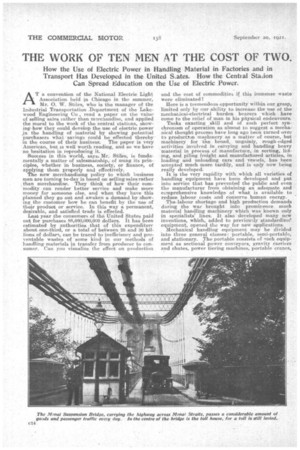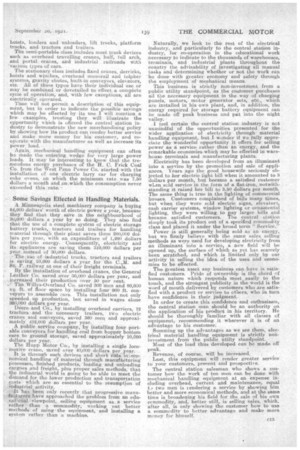THE WORK OF TEN MEN AT THE COST OF TWO.
Page 10

Page 11

If you've noticed an error in this article please click here to report it so we can fix it.
How the Use of Electric Power in Handling Material in Factories and in Transport Has Developed in the United S.ates. How the Central StaLion Can Spread Education on the Use of Electric Power.
AT a convention of the National Electric Light ' Association held in Chicago in the summer, Mr. 0. W. Stiles, who is the manager of the Industrial Transportation _Department of the Lakewood Engineering CO3 read a paper on the value of selling sales rather than merchandise, and applied the moral to the work of the 'central stations, showing how they could develop the -use of electric power ,in the handling of material by showing potential purchasers what savings could be effected thereby in the course of their business. , The paper is very American, but as well worth reading, and so we have no hesitation iii reproducing it.
Success in this world, says: MT. Stiles, is fundamentally a matter of salesmanship, of using ita principles, whether in business, society, or finance, of .applying them properly and effectively.
The new merchandising policy to which business men are turning to-day is based on selling sales rather . than merchandise. They think of how their commodity can render better service and make more money for someone else, and when they have this planned they go out and awaken a demand by ehowing the customer how he can benefit by the use of their product or service. In this way a permanent, desirable, and satisfied. trade is effected.
Last year the consumers of the United States paid out for purchases 88,660,000,000 dollars. It has been estimated by authorities that of this expenditure about one-third, or a total of between 2.5 and 30 billions of dollars, can be traced to inefficiency and preventable wastes of some kind in our methods of handling materials in transfer from producer to consumer_ Can yen visualize the effect on production and the cost of commodities if this immense waste were eliminated ?
Here is a tremendous opportunity within our grasp, limited only by our ability to increase the use of the mechanical-electrical burden bearers which have Come to the relief of man in his physical endeavours.
Tasks exacting Skill and of such perfect synchronism of operation as almost to suggest a mechanical thought process have long ago been turned over to productsan machinery as a matter of course, but machinery for the broad, ungainly, • rough-edged activities involved in carrying and handling heavy material in process of manufacture, in sorting, lilting, and piling freight and manufactured articles, in loading and unloading cars and vessels, has been accepted much more tardily, and is only now being really, developed. It is the very rapidity with which all varieties of handling equipment have been developed and put into service that has prevented the public and even the' manufacturer from obtaining an adequate and comprehensive knowledge of what is available to reduce labour costs and conserve human energy.
The.labour shortage and high production demands during the wa-e brought into prominence much material handling machinery which was known only in specialists' lines. It also developed many new inventions, which, added to previously standardized equipment, opened the way for new applications.
Mechanical handling equipment may be divided into three general classea portable, semi-portable, and stationary. 'jhe portable consists of such equipment as sectional power conveyors, gravity carriers and chutes, power tiering machines, portable cranes, hoists, loaders and unloadGrs, lift trucks, platform trucks, and tractors and trailers.
The semi-portable class includes most track devices such as overhead travelling cranes, half, full arch, and portal cranes, and industrial railroads with 'various types of cars.
The stationary class includes fixed cranes, derricks, hoists and winches, overhead monorail and telpher systems, gravity chutes, biult-in conveyors, elevators, .etc. All of these types have their individual use or may be combined or dovetailed to effect.a complete cycle of operation, and, with few exceptions, all are electrically operated.
Time will not permit a description of this equipment, but in order to indicate the possible savings which may be effected by its use I will mention .a few examples, trusting they will illustrate the opportunity which is offered the central station industry to demonstrate the new merchandising policy by showing how its product can render better service and_ make more money for his. customer, and cooperate with the manufacturer as well as increase its power load.
Again, mechanical handling equipment can often be made the entering wedge for very large power loads. It may be interesting te, know that the. tree meadowenergy purchases of the H, C. Frick Coal Co. from the West Penn Power Co: started with the installation of erie electric larry car for charging coke ovens, on which the minimum rate. was 7.50 dollars a month and on,:which the consumption never exceeded this •rate.
Some -Savings Effected in Handling Materials.
A Minneapolis steel, machinery company is buying 84,000 dollars' worth of electric power a:year, because they find that they. save in the neighbourhood of 3u,000 dollars a year by so doing. They also find that the use of a complete system of electric storage battery trucks, tractors and trailers for handling material through their plant saves them 280,000 dollars per year, with an expenditure or 1,200 dollars for electric energy. Consequently, electricity and its appliances are saving them 310,000 dollars per .yea.r dustead of 30,000 dollars.
The use of industrial trucks, tractors and trailers is saving 50,000 dollars a year for the C.,M. and St. P. railway at one of their freight terminals. By the installation of overhead cranes, the General Leather Co. saved over 30,000 dollars per. year, and increased their production over 50 per cent. The Wiltys-Overland Co. saved 300 men and 80,000 sa. ft. of floor space by installing four 000 ft. conveyors to assemble ears. This installation not only speeded up production, but saved in wages alone 360,000 dollars per year. Deere and Co., by installing overhead carriers, 12 tractors and the necessary trailers, two electric cranes and conveyors, saved 360 men and approximately 432,000 dollars per year. A public service company, by installing four portable conveyors for handling coal from hopper bottom cars to ground storage, saved approximately 10,000 dollars per year. The Hupp Motor Co., by installing a single locomotive crane, saved over 40,000 dollars pee year. . It is through such devices and sheet citte.:irileeo nomical handling Of material through manufaCturing processes, finished products, loading and unloading cargoes and freight, plus proper sales methods,' that the industrial world is going to be able to meet the demand for the lower production and transpertation cests which are DO essential to the resumption industrial activity. It has been only recently that orogre.ssive mannfaCturers.have approached the problem from an educatjonal viewpoint, selling equipment as a service rather than a commodity, working out better methods of usingthe equipnient, and installing a. system rather than a machine.
Naturally, we look to the rest of the electrical industry, and particularly to the central station industry, for co-operation in the educational work necessary to indicate to the thousands of warehouses, terminals, and industrial plants throughout the country the advisability of investigating all manual tasks and determining whether or not the Work can be done with greater economy and safety through the employment of meehanical means.
This business is strictly non-investment from a public utility standpoint, as the customer purchases all the necessary equipment in the way of charging panels, motors, motor generator sets, etc., which are installed in his own plant, and, in addition, the energy required for storage battery equipment can be made off peak business and put into the night valley.
. I feel certain the -central station industry is not unmindful of the opportunities presented for the wider application of electricity through material handling equipment, but wonder if we fully appreciate the wonderful opportunity it offers for selling power as a service rather than an energy, and the remarkable ecanomies-which may be effected in Warehouse terminals and manufacturing plants.
Electricity has been developed from an illuminant into a service by the promotion and sale of appliances. Years ago the good housewife seriously objected to her electric light bill when it amounted to 3 dollars per month, but became a satisfied customer l
wen sold service in the form of a fiat-iron, notwithstanding it raised her bill to 3.50 dollars per month. The same thing is true in the lighting of commercial houses. Customers complained of bills many times, but when they were seld electric signs, elevators, cash carrier systems, window lighting or ornamental lighting, they were willing to pay larger bilks and became satisfied customers. The central station simply took its product out of a specified commodity elasS and placed it under the broad term " Service.
Power is still generally being sold' as an energy, but we firmly believe with the same sales selling methods as were used for developing electricity from an illuminant into a -service., a new field will be opened up, the surface of which as yet has scarcely been scratehed, and which is limited only by our aotivity in selling the. idea of the use and economies to be effected.
The, greatest asset any business can have is satisfied customers. Pride of Ownership is the chord of human nature which responds most easily to the touch, and the strongest publicity in the world is the word a mouth delivered by customers who are satisfied with a product or service to others, who in turn have confidence in their judgment.
In order to create this confidence and enthusiasm, the central station man should be an authority on the application of his product in his territory. He should be thoroughly familiar with all classes of equipment, recommending it wherever it is of an advantage to his customer.
Summing up the advantages as we see them., electrical material handling equipment is strictly noninvestment from the public ritilt Y standpoint. Most of the load thus developed can be made off peak. Revenue, of course, will be increased.
Last, this equipment will render greater service to your customers, present and prospective.
The central station salesman who shows a customer how the work of ten men can be done with mechanical handling equipment at an expense including overhead., current and maintenanee, equal te two men is iendering a service by showing him better and more economical methods, and at the same time is broadening his field for the sale of his own cernmodity, and, better still, is selling sales, which, after all, is only showing the customer how to use a commodity to better advantage and make more money for himself.
































